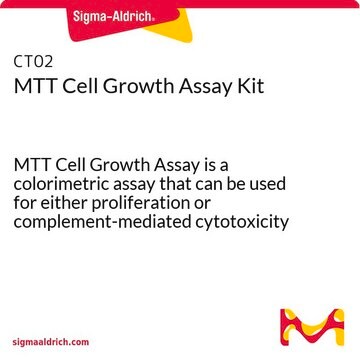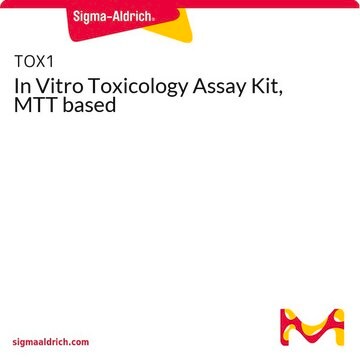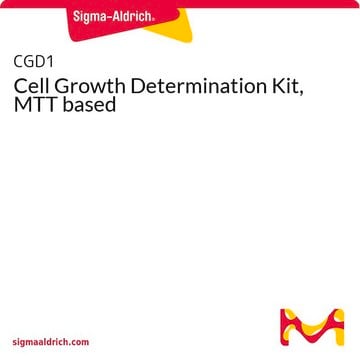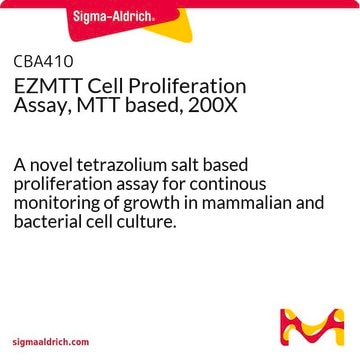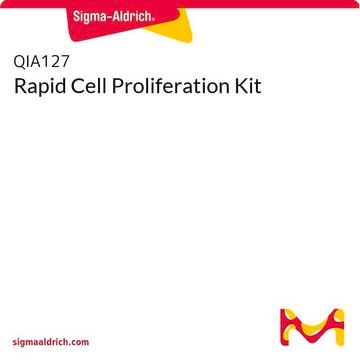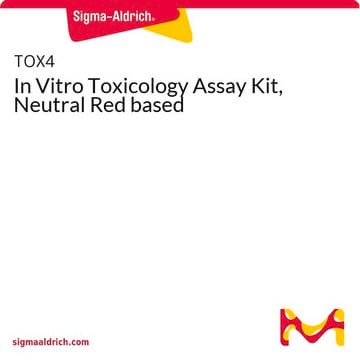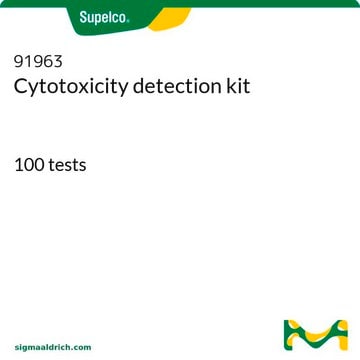CT01
MTT Cell Growth Assay Kit
MTT Cell Growth Assay is a colorimetric assay that can be used for either proliferation or complement-mediated cytotoxicity assays.
Synonyme(s) :
MTT Formazan Assay
About This Item
Produits recommandés
Niveau de qualité
Fabricant/nom de marque
Chemicon®
Technique(s)
activity assay: suitable
cell based assay: suitable
Conditions d'expédition
wet ice
Description générale
Application
1. Carry out a lymphokine, mitogen, or complement-mediated cytotoxicity assay using standard methods, in 96-well flat-bottomed tissue culture plates of good optical quality (e.g. Falcon). The final volume of tissue culture medium in each well should be 0.1 mL, and the medium (e.g. RPMI or DMEM) may contain up to 10% Fetal Bovine Serum.
2. At the end of the assay add 0.01 mL AB Solution (MTT) to each well. Mix by tapping gently on the side of the tray.
3. Incubate at 37°C for cleavage of MTT to occur. Optimal times may vary according to the assay, but four hours is suitable for most purposes. At the end of this time, the MTT formazan produced in wells containing live cells will appear as black, fuzzy crystals on the bottom of the well.
4. Add 0.1 mL isopropanol with 0.04 N HCl to each well. Mix thoroughly by repeated pipetting with a multichannel pipettor. The HCl converts the phenol red in tissue culture medium to a yellow color that does not interfere with MTT formazan measurement. The isopropanol dissolves the formazan to give a homogeneous blue solution suitable for absorbance measurement.
5. Within an hour, measure the absorbance on an ELISA plate reader with a test wavelength of 570 nm and a reference wavelength of 630 nm. After several hours at room temperature, serum proteins may begin to precipitate due to the acid/alcohol. Chilling the plates will hasten the precipitation. If the plates must be stored before measuring, keep at 4° C before adding the acid/alcohol, then warm to room temperature and add acid/alcohol just before reading.
Results:
The MTT assay will normally detect 200 to 50,000 cells of a typical cell line, although 1,000 to 50,000 is the useful range. This number may vary for other cell types. Cytotoxic assays should be set up so that the control, unlysed cells give a signal of 0.2 to 0.4, and proliferation assays should yield a similar value at plateau concentrations. This corresponds to about 20-50,000 cells per well with a typical cell line.
Absorbance is directly proportional to the number of cells; actual cells do not absorb significantly, even up to concentrations of 1 x 106 cells/mL.
Composants
Solution B: PBS pH 7.4, 60 mL
Stockage et stabilité
Reagent Preparation:
For every 1,000 assays to be performed, add 10 mL Solution B to one vial of Reagent A. Mix well, sterile filter and keep in the dark at 4° C until used. Note: It may take overnight to dissolve. Do not heat solution. When absolutely required to dissolve crystals, adjust pH with 1-2 drops of HCl. The AB mixture is stable for several weeks under these conditions.
Informations légales
Clause de non-responsabilité
Mention d'avertissement
Warning
Mentions de danger
Conseils de prudence
Classification des risques
Eye Irrit. 2 - Muta. 2 - Skin Irrit. 2 - STOT SE 3
Organes cibles
Respiratory system
Code de la classe de stockage
10 - Combustible liquids
Certificats d'analyse (COA)
Recherchez un Certificats d'analyse (COA) en saisissant le numéro de lot du produit. Les numéros de lot figurent sur l'étiquette du produit après les mots "Lot" ou "Batch".
Déjà en possession de ce produit ?
Retrouvez la documentation relative aux produits que vous avez récemment achetés dans la Bibliothèque de documents.
Les clients ont également consulté
Articles
Serum-free defined cancer stem cell media used to grow and expand cancer cells in 3D tumorsphere aggregates.
Quality control guidelines to maintain high quality authenticated and contamination-free cell cultures. Free ECACC handbook download.
Tests sur cellules pour l'étude de la prolifération (BrdU, MTT, WST1), de la viabilité et de la toxicité cellulaires pour la recherche sur le cancer, la recherche en neurosciences et la recherche sur cellules souches.
Cell based assays for cell proliferation (BrdU, MTT, WST1), cell viability and cytotoxicity experiments for applications in cancer, neuroscience and stem cell research.
Notre équipe de scientifiques dispose d'une expérience dans tous les secteurs de la recherche, notamment en sciences de la vie, science des matériaux, synthèse chimique, chromatographie, analyse et dans de nombreux autres domaines..
Contacter notre Service technique
